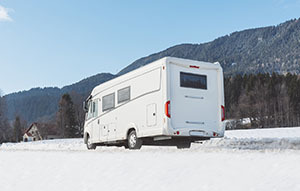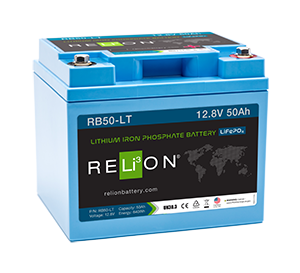In this week’s blog, we’re discussing the Low Temperature, or LT, line of RELiON lithium batteries. Lithium batteries have limited charging capabilities in temperatures below 32°F (0°C) – therefore, having a battery designed specifically for low-temperature conditions can help extend the life of your battery and keep you powered. This week we’ll review what LT is, why it’s needed, how LT models function, and how to choose the right LT model for your application.
What are Low Temperature (LT) Models?
The RELiON LT line consists of the RB20-LT, RB52-LT, RB100-LT, and RB300-LT. Following our standard naming convention, the RB stands for RELiON Battery, the number refers to the amp hour capacity, and LT stands for Low Temperature. LT models also contain a heating element that uniformly heats the cells within the battery to a safe temperature so that it can be charged at its full recommended current.
What happens without LT?
LiFePO4 batteries function from the electrochemical potential of metal, specifically the electrolyte within the battery carrying lithium ions between the anode and the cathode during charging and discharging. All batteries function best in mild to warm climates, since the electrochemical process slows the colder it becomes. Although you may notice reduced capacity in temperatures below 32°F (0°C), it is perfectly safe to discharge your LiFePO4 batteries in temperatures down to -4°F (-20°C). During discharging, lithium ions intercalate into the cathode. Think of discharge intercalation as the lithium ions navigating their way “home” to the lithium iron phosphate cathode after work, which they do just fine in cool temperatures.

However, charging in freezing temperatures is a different story. In freezing charging conditions, lithium ions get lost navigating their way to “work” within the graphite anode. Instead of intercalating, these ions end up plating the surface of the anode. Charging in freezing temps can cause plating, which reduces battery capacity and increases resistance. If enough plating builds up, it can puncture the separator and create a dangerous short inside the cell.
A standard RELiON lithium battery (without the LT heating element) can be charged between 113° to -4°F (45° to -20°C) . To prevent causing previously mentioned plating damage, the following guidelines must be followed in freezing temperatures. When temps fall between 32° and 14°F batteries cannot be charged at higher than .1C. When temps fall between 14° and -4°F batteries cannot be charged at higher than .05C. These limiting guidelines increase charging duration and complicate the entire process because you may not know how cold it could become during a charging cycle.
Imagine going to sleep in 45°F weather and waking up to a cold snap at 15°F. If a charge cycle were initiated automatically in the middle of the night and you did not have RELiON LT model batteries, irreparable damage could have been done.
How Do LT Models Work?
When a charge cycle is initiated in freezing temperatures, the battery management system (BMS) diverts the current to the heating element instead of to the cells. The heating element functions until the uniform internal temperature of the battery reaches its specified safe temp, at which time it allows the current to charge the cells. Uniform internal heating is an important feature of the LT model, as many external heating blanket options currently available cannot sense the internal temperature of the cells and may not be completely effective at heating the battery throughout. Depending on how cold it is and which LT models you are using, the BMS sources 5 to 15 charging amps to power the heating element. Heating usually takes between one and 1.5 hours to thoroughly heat batteries to specified temperatures. LT batteries may NOT be connected in series, but can be connected in parallel.
When using a shunt-based battery gauge with LT models, it’s important to note that the gauge will not differentiate between heating amps and charging amps, so your battery gauge may read as full before the charge finishes. To ensure your batteries are completely refilled, be sure to allow the charge to complete even if the gauge shows 100%.

Choosing the Right LT Model
We’ve recently expanded our offering of LT models by adding the RB52-LT and RB300-LT. The RB20-LT and RB52-LT are great for smaller camping or overland adventure applications, while our RB100-LT and RB300-LT are better suited in recreational vehicles or stationary applications.
Our LT batteries can be used in almost any cold weather application and batteries should be chosen based on your capacity needs coupled with your space and weight requirements. You can see how to calculate your usage needs as we’ve shared in previous articles here.
If you have any questions about our LT Series or need help selecting the best model for your needs, please contact us.
About the Author:

Chi Woodruff is a Sr. Product Manager at RELiON Battery. Chi's experience includes product management in distribution and manufacturing industries along with a history of analysis, product launches, rebranding and life-cycle management in the battery industry. In his free time, Chi is an avid runner and pacer at many races in Southern California. Keep up with Chi on LinkedIn here.